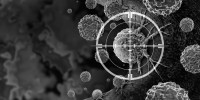
Role of circ-FBXW7 in Lung Cancer Therapy
Lung cancer remains a daunting challenge, with its devastating impact on countless lives. Although targeted therapies like tyrosine kinase inhibitors (TKIs) have shown promise, the emergence of resistance and disease progression hampers long-term treatment success.
In their new study, researchers delved into the intricate mechanisms behind therapy resistance in lung cancer, shedding light on the pivotal roles of stem cells, the Wnt signaling pathway, and circular RNAs (circRNAs). This novel research unraveled exciting findings, unraveling a complex interplay that could potentially pave the way for innovative treatment approaches. Read on to discover how these discoveries could revolutionize lung cancer management and offer hope to patients worldwide.
Lung cancer remains a significant health concern, and despite advancements in diagnosis and treatment, it continues to claim numerous lives. Targeted therapies, such as tyrosine kinase inhibitors (TKIs), have shown promise in improving treatment responses with fewer side effects. However, the emergence of resistance and disease progression in some patients undergoing long-term treatment remains a challenge. Understanding the underlying mechanisms driving therapy resistance is crucial for developing effective strategies. Recent research has shed light on the involvement of stem cells and the Wnt signaling pathway in lung cancer progression and therapy resistance. However, the role of circular RNAs (circRNAs) in lung cancer treatment and their interactions with TKIs have yet to be fully explored.
 While the involvement of circRNAs in cancer initiation, progression, resistance, and recurrence has been extensively studied, their specific roles in lung cancer treatment, particularly their interactions with TKIs, remain poorly understood. In an attempt to uncover the potential functions of specific circRNAs in mediating resistance or sensitivity, we embarked on an investigation to determine the consequences of manipulating circRNA expression and functions in lung cancer stem cell populations.
While the involvement of circRNAs in cancer initiation, progression, resistance, and recurrence has been extensively studied, their specific roles in lung cancer treatment, particularly their interactions with TKIs, remain poorly understood. In an attempt to uncover the potential functions of specific circRNAs in mediating resistance or sensitivity, we embarked on an investigation to determine the consequences of manipulating circRNA expression and functions in lung cancer stem cell populations.
Flow cytometry, FACS, ALDH1-based flow analysis, and other assays performed
In this new study, various experimental techniques were employed to investigate the mechanisms of therapy resistance and stem cell regulation in lung cancer. Flow cytometry and fluorescence-activated cell sorting (FACS) were used to analyze and separate cancer stem cell populations based on specific markers. ALDH1-based flow analysis quantified ALDH1-positive cells. Cell division and staining assays, M6A methylation quantification assay, co-immunoprecipitation (CoIP) assay, and survival analysis were performed. The researchers also utilized online databases for clinical parameter analysis. Statistical analysis was conducted using GraphPad Prism and SPSS software. Cell culture, CCK-8 assay, sphere formation assay, quantitative real-time PCR, western blot, circRNA microarray, and m6A-circRNA epitranscriptomic microarray techniques were employed for data generation.
Investigating Wnt Signaling Activation in Lung Adenocarcinoma
The study focused on investigating the role of Wnt signaling activation in lung adenocarcinoma and its impact on survival outcomes and resistance to TKI treatment. The researchers observed dysregulation of Wnt signaling factors, including SOX and Snail, in lung cancer tissues. Overexpression of these factors was associated with poorer overall survival and progression-free survival. The study also explored the relationship between Wnt signaling activation and stem cell renewal, suggesting that the number and renewal of stem cells influenced therapy resistance. Analysis of the effects of Wnt signaling activation on the response to Osimertinib treatment, a TKI, revealed significant correlations with diverse treatment responses and long-term therapeutic outcomes.
Dysregulated circRNAs and Their Role in Therapy Resistance
The researchers identified potential markers for identifying stem-like cells in TKI-resistant lung cancer cells. Dysregulated circRNAs were found to be involved in microRNA functions and cell division processes associated with therapy resistance. Among these circRNAs, circ-FBXW7 emerged as a potential suppressor of cancer progression. The study also highlighted the involvement of m6A modification, an RNA modification associated with abnormal mRNA expressions and molecular dysfunctions, in therapy resistance.
Understanding the Role of circ-FBXW7 in Lung Cancer Progression
The researchers discovered that resistant cells exhibited higher m6A levels compared to sensitive cells, suggesting m6A involvement in therapy resistance. Further investigation revealed that m6A stimulation influenced the translation efficiency of circ-FBXW7, with YTHDF3 identified as a key regulator of circ-FBXW7 expression. The researchers confirmed the role of YTHDF3 in controlling stem cell proliferation. The study demonstrated that overexpression of circ-FBXW7 inhibited stem cell proliferation and promoted differentiated cell division. Circ-FBXW7 was found to interact with β-catenin, a key protein in the Wnt/β-catenin signaling pathway, and negatively regulated its stability. The study also revealed a connection between circ-FBXW7 and Let-7 family miRNAs, which are involved in Wnt/β-catenin pathway regulation. Circ-FBXW7 was found to stimulate Let-7d expression, and Wnt signaling inhibition increased Let-7d expression in resistant cells. The researchers proposed a positive signaling loop involving circ-FBXW7, Let-7d, and Wnt/β-catenin signaling.
Summary of the study's findings and their significance in lung cancer research
The study provides valuable insights into the role of Wnt signaling activation, stem cell renewal, circRNAs, m6A modification, and Let-7d in lung adenocarcinoma progression and therapy resistance. Understanding the intricate mechanisms underlying therapy resistance is crucial for developing targeted strategies to overcome it. The identification of circ-FBXW7 as a potential regulator of cancer progression and stem cell division patterns opens up new avenues for therapeutic interventions in lung cancer. Further research in this field could lead to the development of innovative treatment approaches to improve patient outcomes and quality of life.